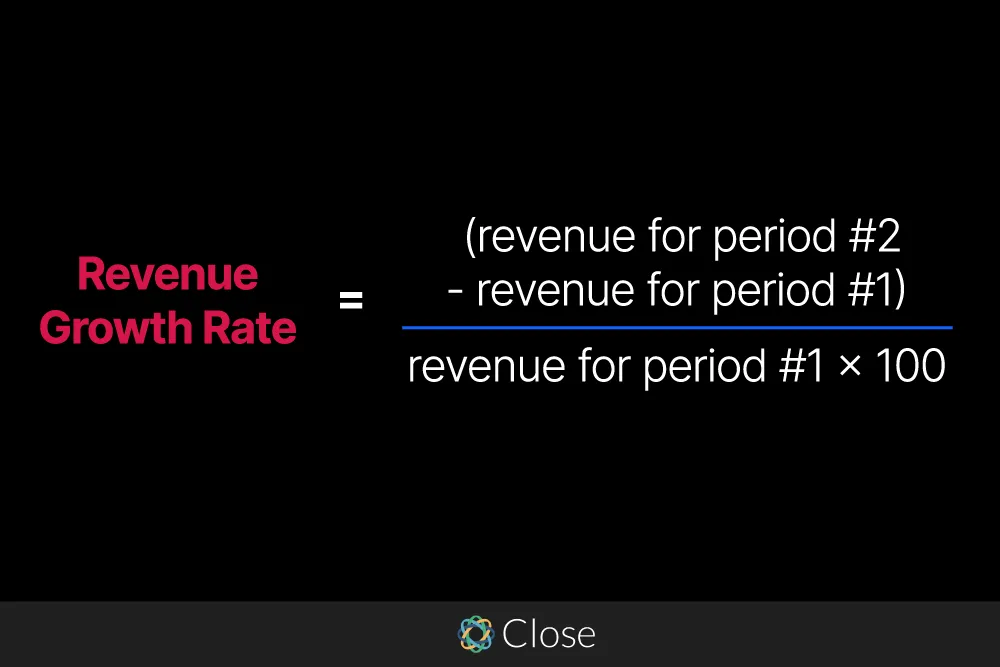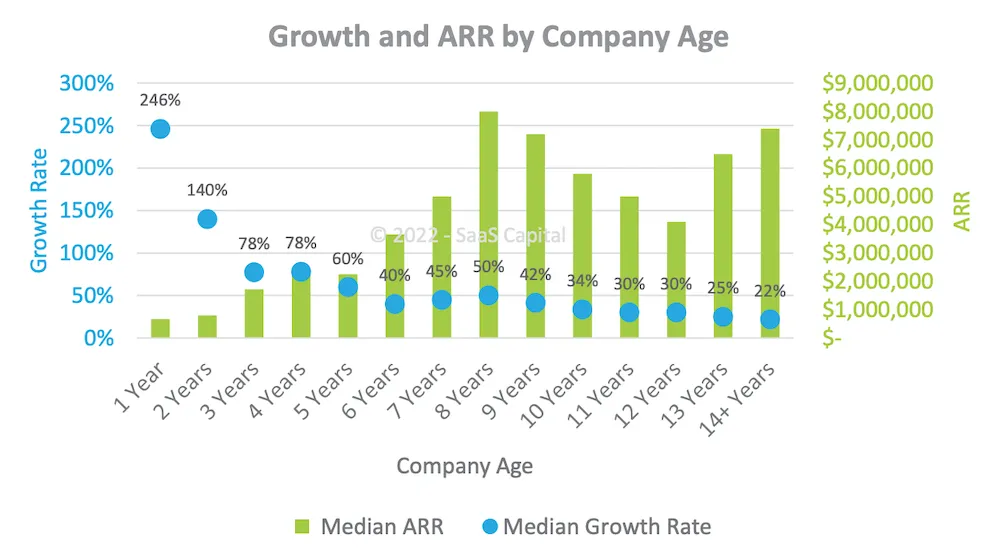
The secret to driving revenue growth? It might just lie in how well you're utilizing your CRM system.
You might be thinking, "Isn't CRM just for keeping track of customers?" If you're only using a CRM to manage customer data, you're missing out. It's time to unlock its full potential.
CRM isn't just an organizational tool—it's a powerful strategy that can grow your revenue. It lets you create a fantastic experience for every person you serve, from cold leads to loyal customers. With a CRM strategy, you can build strong relationships and drive your business growth.
Let's dig in and explore how your CRM can fuel your revenue growth.
How to Measure Your Revenue Growth Rate
Companies can use a yearly revenue growth rate, a monthly revenue growth rate, or both to analyze their performance—yearly makes more sense the longer the company exists. To simplify this process, utilize our revenue growth calculator to get quick and accurate results.
The formula to calculate your revenue growth rate is as follows:
 |
In this formula, period #1 is the preceding timeframe, and period #2 is the one that followed. For example, if you were calculating your yearly revenue growth rate, period #1 would be your 2022 revenue, and period #2 would be your 2023 revenue.
Here’s what this formula looks like with sample data:
You can apply the same formula to calculate the monthly revenue growth rate—just make sure to use subsequent months.
Revenue growth is one of the key sales KPIs and metrics that tell you if your business is on the right track and growing. In the context of revenue, some others you’ll want to keep an eye on are your return on sales ratio (ROS) to measure your operational efficiency, as well as your ARR and ACV—annual recurring revenue and annual contract value—to have a full picture of your company’s revenue.
What Is Considered a Good Revenue Growth Rate?
As with many things in business, the answer is: it depends. But here are some benchmarks you can check out to estimate how well you’re doing:
The 2022 report by SaaS Capital that surveyed over 1,500 private SaaS companies revealed the overall median growth rate of 40 percent, which is an increase from an overall median of 29.6 percent in 2020.
Growth rate is highest for young startups—partially due to small base revenue—and stabilizes around year six.
 |
There’s more data and additional context in the SaaS survey by KeyBanc, which included over 100 companies:
- The yearly revenue growth rate across the board is 26 percent
- Companies with less than $10 million in yearly revenue have the highest yearly growth rate of 50 percent, and those with between $50 and $100 million yearly revenue the lowest at 18 percent
- In 2022, companies utilizing a field sales approach accounted for an average of 59 percent of new Annual Recurring Revenue (ARR), significantly outperforming those with inside sales approaches, which contributed only 25 percent, and channel sales, which made up 11 percent
A simplified answer, then, would be: if your yearly revenue growth rate sits between 25 percent and 45 percent, you’re golden.
What are the Benefits of a CRM for Revenue Growth?
There’s no revenue growth without growing either your customer base, how much they spend with you through upselling and cross-selling, or both.
So the value of a CRM—customer relationship management—is right there in its name. Here are the core benefits of a CRM tool:
CRM Makes Sales Reps More Productive and Efficient
Do you know the way lawyers have billable hours? Those are hours lawyers can bill clients for work they’ve done for them, and it’s how legal firms make money.
In sales, your "billable hours" refer to the time you spend selling to your prospects. Now think about this statistic: sales reps only spend around 28 percent of their week prospecting or in sales conversation—in other words, actually selling.
The remaining 72 percent? It’s spent on admin, internal meetings, manual data entry, research, and prep work.
A CRM system lets you spend more time selling because it minimizes everything else through automation, templates, and more.
CRM is a Single Source of Truth for Winning and Retaining Customers
Even though we’re talking about CRM software as a sales tool, it benefits every person and process that touches your customers. For example:
- Marketers can learn about the challenges and needs of your best customers, and how your products helped them, to optimize marketing campaigns
- Customer success reps can customize the onboarding process based on sales conversations recorded in the CRM
- Customer support reps can close tickets faster because they can get full context about a customer instantly
And when all teams use a shared CRM, they’re 14 percent more likely to provide exceptional customer experience. Actionable data at everyone’s fingertips is priceless.
 |
CRM Helps You Improve Every Step of Your Sales Process
Finally, your CRM doesn’t lie. It reveals how well you’re doing across your sales pipeline because it shows you how many new leads enter your sales funnel, how many you convert at each stage of the funnel, the revenue they bring into the business, and how long it takes you to convert them.
That’s a good thing. This data lets you find areas to refine.
For example, you might spot that prospects you reply to quicker tend to convert better, so you can implement an automated workflow that helps you speed up your replies.
Or you identify a type of customer that ends up being a poor fit—they have low spend or lifetime value, but are a headache to support. With this information, you can improve your sales process and weed out poor fit prospects so you can focus on the right ones.
If you want to unlock self-management prowess even without a CRM budget, dive into our guide for crafting your very own sales-focused solution.
7 Strategies to Drive Revenue Growth with a CRM
Here are seven things you can do to gain instant return on investment from your CRM and increase your revenue year after year.
1. Streamline Your Sales Process
We’ve already established that your team might be spending too much time doing manual work—follow-ups, tracking down the right contact information, chatting with fellow sales reps to find the right piece of information—to move potential customers further down the sales funnel.
It’s safe to assume you’d want things to happen quicker and move smoothly.
A CRM is a catalyst for sales productivity thanks to its automation capabilities. Automation lets you do the work once and reap rewards on repeat. For example, you can:
- Clone and repurpose proven templates, like follow-ups and value-building emails
- Send a check-in SMS three days after your most recent email
- Build nurture campaigns for long sales cycles, so qualified leads don’t slip through the cracks
Instead of spending your days navigating complicated spreadsheets and dozens of reminders in five different apps, you can let your CRM take care of the minutia so you can focus on building stronger relationships and closing higher-value deals.
Check out Close’s sales automation process guide so you can turn your CRM into a revenue-growing machine.
2. Use Data to Better Know and Serve Your (Potential) Customers Well
“A person’s name is to him or her the sweetest and most important sound in any language,” Dale Carnegie once said.
The name of your lead or customer is just one small piece of the puzzle that makes them—them. Their preferences, behaviors, needs, and real-life challenges make up the rest.
Instead of trying to remember all of that, or trying to keep track of this data in random digital notes or even physical notebooks, lean on your CRM to keep track of everything that can help you add value to a customer in the future.
This might be:
- Communication preferences
- Birthday
- Location and language
- Competitors they used previously
- Specific details about a pain point
Personalizing every interaction—down to knowing that someone wants to be addressed as Frau rather than Mrs, thanks to features like Contact Custom Fields—can result in a reply and a productive conversation instead of silence.
 |
And because a CRM makes your sales notes public, you can empower your teammates to take the right actions even in your absence.
3. Improve Customer Retention
Right in line with the topic of deeply understanding your leads and customers is customer retention, because one leads to the other. Retaining your customers can look like this:
- Checking in with them every X months to ask them about their experience and see if they need any assistance
- Responding to and solving their customer support queries quickly
- Recognizing their usage and buying patterns to offer them additional products or features that match their needs
Imagine a CRM empowering you enough with info about your current customers that you’re able to tell them:
“Last time we talked, you mentioned that [pain point] is a key struggle for your team. With our [add-on], you can completely eliminate that issue.”
Instead of stopping once you’ve completed the sales cycle—a.k.a. converted a lead into a new customer—focus on existing customers, too, and look for opportunities to make their life as your customer even better.
Because solving problems in a timely and understanding manner = customer loyalty and retention = revenue growth. Everyone wins.
4. Improve Alignment Between Marketing and Sales Teams
When your marketing team is aligned with sales, it creates a frictionless customer journey and makes your job of converting leads into customers easier.
But there’s more nuance to it: this alignment doesn’t only increase your sales conversion rate. Your company’s long-term revenue benefits, too, because you’ll work with better-fit leads that will likely spend more—and churn less—in the future.
Take this example:
Let’s say you’re converting leads with 200 employees at a similar rate to those with 1,000 employees. On the surface, both fall into the definition of a good lead. But within a year of having them on board, you learn that the 200-employee companies tend to downgrade their plans and require more hands-on customer support compared to the 1,000-employee companies.
Not just that: you realize they tend to churn at least twice as often.
Your CRM will help you and marketers that generate leads for you to notice this quickly and course correct accordingly. The result? You get to turn the marketing budget into revenue for years to come.
5. Improves Sales Pipeline Visibility
This one’s easy: use your CRM to identify leads in your pipeline that require your action right now.
That can be a hot lead, like someone who has asked for a product demo or signed up for a free trial. They’re in or around the decision stage, and you better not let them slip.
Or it could be a current customer who’s looking into upgrading their plan or indicating they need more from your product than they already have. It means they might be looking elsewhere for a solution, too, so there’s a risk of losing them.
Right now, you might spot these opportunities when it’s already too late. A good CRM will notify you when these things are brewing so you can be right on it.
6. Improve Sales Analysis and Tracking
How close are you to hitting your sales goals? What product, sales rep, or period performed better or worse than others? How is the market doing? And what might your next quarter look like?
If your customer data, pipeline stats (like how many leads move from cold leads to qualified leads), and revenue for different products and segments are all buried in inaccessible tables and quarterly reports, you’ll struggle to answer any of those questions—or change anything based on the answers.
Dig into your CRM to slice and dice data like:
- How did LinkedIn leads perform compared to those from PPC campaigns?
- What’s your most successful follow-up email?
- Which rep is doing better than others, and why?
- How do sales fluctuate for a specific product throughout the year?
This just scratches the surface. Use CRM data to find your most successful sales strategies so you can double down and grow your revenue.
 |
7. Integrate Your CRM with Other Tools
Finally, your CRM doesn’t need to do everything. It needs to do just about what we covered up to this point—and then it needs to play well with other powerful tools you use in your business.
That can include call scheduling software, e-signature and invoicing tools, robust email marketing platforms, or a customer support tool.
With a native integration in place, you get instant context about a lead and avoid spending extra time moving information from one place to the other—so you can focus on selling. Check out integrations you can use with Close.
What Factors Should You Consider When Choosing a CRM for Revenue Growth?
The best CRM is the one your sales team will use and rely on daily. Fanciest solutions are nothing if you only log into them twice per month and keep using your old spreadsheets.
But different CRMs fit different types of companies better. Consider these factors when choosing yours:
- Company needs: Think about the size of your business, the number of users that will need access, specific features you’re looking for, use cases the CRM works for, and the goals you want to hit. If you sell accounting software, using a CRM made for real estate companies will give you a terrible time.
- Data privacy and security: This is table stakes; make sure your options comply with security standards like SOC 2, GDPR, and CCPA.
- Ease of use: Involve your salespeople in the decision to find a CRM that’s user-friendly for maximum user adoption and efficiency. Give special attention to options to customize dashboards, templates, and workflows.
- Pricing: Consider the total cost of ownership once you take into account all features you need and the number of seats you’re buying.
- Mobile access: If your reps are ever on the go, make sure they have instant access to their inbox, sales notes, and opportunities so they can take quick action and win new revenue. The Close mobile app is exactly that.
Accelerate Your Revenue Growth with the Best CRM
Now you know: a CRM solution is a revenue-growing powerhouse.
It gives you the chance to delight customers, simplify workflows, enable easy collaboration, keep sales reps happy and on top of everything—and maximize your revenue potential.
Implementing a CRM can be a game changer for your bottom line and your revenue growth, not just this year, but every year. Want to try it for yourself? See what’s possible with this 14-day free trial of Close.










